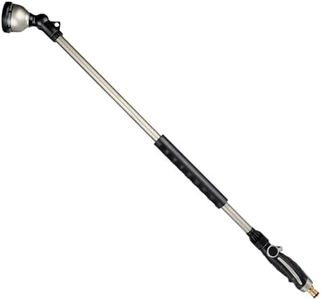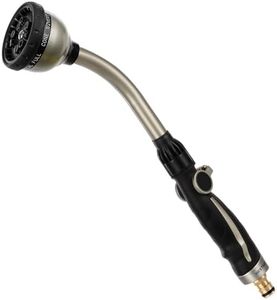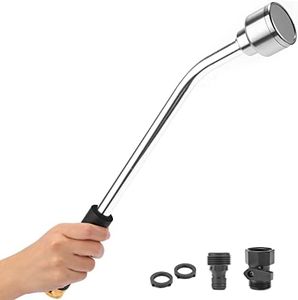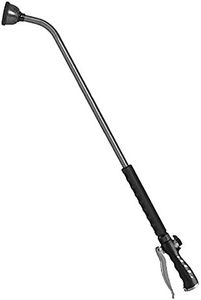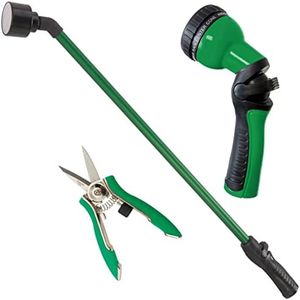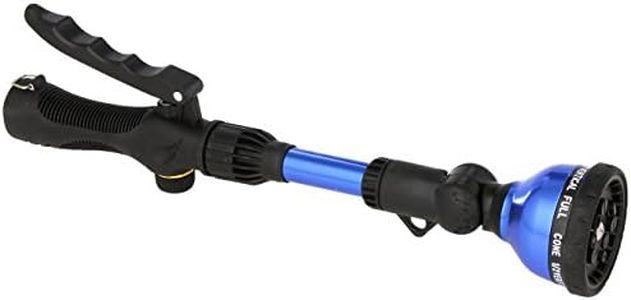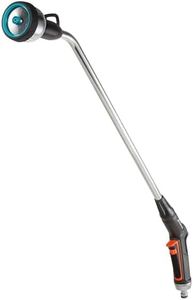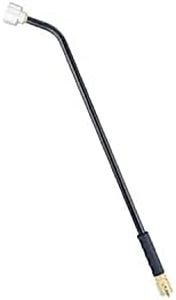We Use CookiesWe use cookies to enhance the security, performance,
functionality and for analytical and promotional activities. By continuing to browse this site you
are agreeing to our privacy policy
10 Best Watering Wand
From leading brands and best sellers available on the web.Buying Guide for the Best Watering Wand
Choosing the right watering wand can make garden and plant care easier, more precise, and even enjoyable. The key to a good purchase is knowing where and how you'll mostly use it—think of what you’ll be watering (flower beds, hanging baskets, delicate seedlings, shrubs) and how far your reach needs to be. Consider what your garden looks like, if you have trouble with heavy equipment, and whether you want advanced features. A well-chosen wand helps you water your plants thoroughly without wasting water or straining yourself.LengthThe length of a watering wand determines how far you can reach and how easy it is to water hard-to-reach spots, such as hanging baskets or the back of garden beds. Short wands (around 15 to 18 inches) are easy to maneuver but may not reach high or deep spaces. Medium wands (around 24 to 30 inches) offer a good balance for general use. Extra-long wands (36 inches or more) let you comfortably water tall or distant plants without bending or stretching. Choose the length based on your garden’s layout—if you need to reach high up or over wide beds, go longer; for close quarters or potted plants, shorter usually works well.
Spray Head Type and PatternsThe spray head disperses water in different patterns, ranging from a gentle mist to a steady shower or even a powerful jet. More spray patterns provide flexibility for different plants—delicate seedlings may need a fine mist, while larger bushes might benefit from a heavier spray. Wands with multiple selectable patterns are versatile for mixed gardens, but if you always water the same kind of plants, a single-pattern wand may be enough. Consider your usual watering tasks to decide if you need multiple spray patterns or just one.
Flow ControlFlow control refers to the ability to adjust how much water comes out of the wand, often through a thumb or trigger valve. This is important for saving water and preventing overwatering, especially with young plants. Some wands have simple on/off switches, while others let you finely adjust the flow. If your plants need more delicate or varied watering, or you want to avoid walking to the tap often, a wand with smooth, adjustable flow control is very useful.
Grip Comfort and MaterialThe grip is what you hold onto, so comfort is key, especially if you water for long periods. Features like cushioned or ergonomic handles reduce hand fatigue. The material—often plastic or metal—also affects weight and durability. Lighter wands are easier on the arms, but metal wands may last longer. If you struggle with strength or hand pain, prioritize comfort and lighter weight; if you need something long-lasting, focus on durable materials.
Build Quality and DurabilityBuild quality covers how solidly the wand is made and if it will hold up to repeated use in different conditions. A sturdy metal or reinforced plastic wand is less likely to break or leak. If you plan to use your wand frequently or in tough outdoor conditions, look for robust materials and check if parts like hoses or triggers are reinforced for strength. If you only water occasionally, a basic, lighter design may suffice.
Ease of Storage and MaintenanceThis refers to how easy it is to clean and store your wand, which helps it last longer. Some wands have removable heads for cleaning out mineral buildup, or built-in holes for easy hanging. If you have limited storage space or live in an area with hard water, choose a wand that’s easy to take apart and store away. Keeping things simple will make your gardening more convenient.

